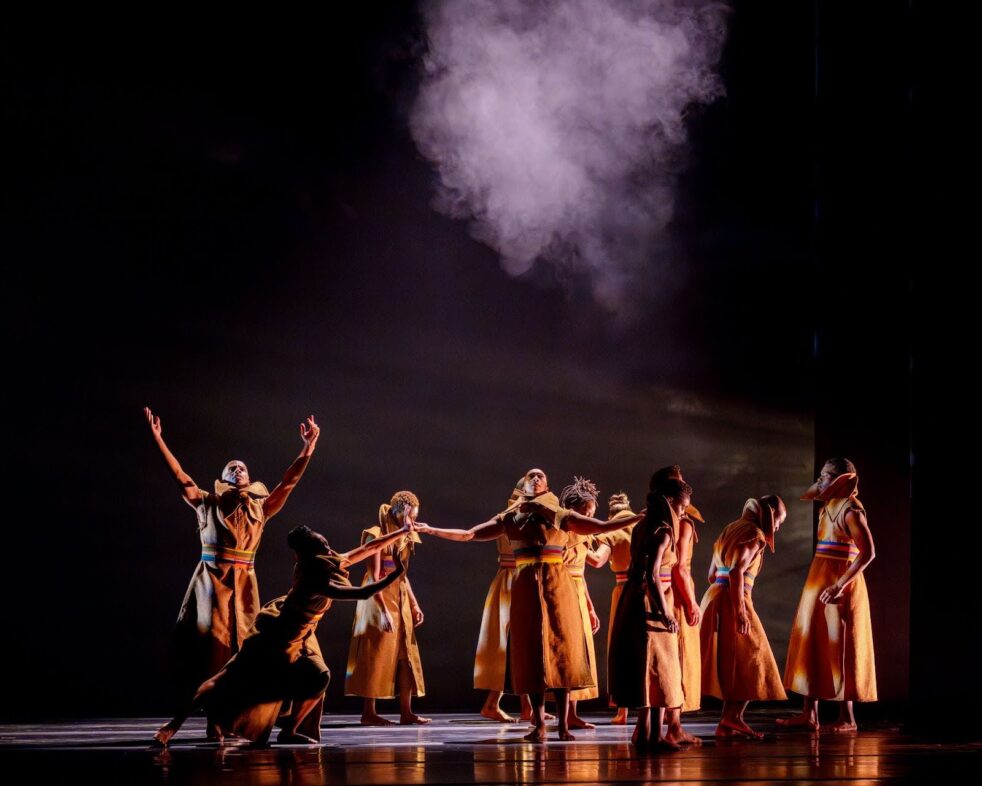From Feb. 12-16, Alvin Ailey American Dance Theater brought its national tour to Atlanta’s Fox Theatre, showcasing a new selection of performances each day.
Founded in 1958, the company upholds Alvin Ailey’s practice of modern dance, fusing Afro-diasporic, Native American and European styles with anatomical science. Through his work, Ailey sought to honor Black heritage, which he described as one of America’s greatest treasures: “sometimes sorrowful, sometimes jubilant, but always hopeful.”
Wednesday’s program opens with “Grace” (1999) by Ronald K. Brown, and the performance is spellbinding. A solemn woman draped in white enchants the stage with grounded pliés and open arms. Echoing the vulnerable strength of Duke Ellington’s “Come Sunday,” she is Brown’s “Mother God” figure.
Dancers in red seize control of the stage to the jazzy Afrobeat melody of “Shakara” by Fela Kuti mixed over house track “Rock Shock” by Roy Davis Jr. They bounce, glide and erupt in exquisite, hypnotic synchrony, acting as Brown’s metaphor for earthly pleasure. Onlookers throughout the Fox nodded along to the groove.
Four dancers in white drift onto the stage, briefly interrupting the red dancers’ rhythm before joining in. Gradually, all of the dancers don white costumes, marking their journey beyond temporal satisfaction into eternal bliss. Brown’s narrative reaches its crux: his characters have found grace.
Drenched in sweat, the dancers move as one body beside the “Mother God.” “Come Sunday” returns, this time sung by Jennifer Holiday, pouring out: “God of love, please look down and see my people through.” All the dancers surrender to each other’s embrace — except for one. Brown’s nuance reveals not everyone shares the desire to transcend.
In an interview with The New York Times, Ailey dancer Solomon Dumas elaborated: “The idea of grace is that we receive blessings when we don’t even deserve it. … It’s like when Mr. Ailey said he wants to hold up a mirror to society to show people how beautiful they are; I do believe that Ron is a manifestation of that expression.”
Next is “Finding Free” (2024) by Hope Boykin, tailored to an original score by Matthew Whitaker. While the disorienting choreography feels less raw or resonant than “Grace” and “Revelations,” the production design keeps the piece an exciting watch.
The music begins, percussive and bass-heavy. The dancers huddle tensely beneath the fog, cloaked in sleeveless trench coats with oversized lapels. They jolt and spin until their coats unravel into dense, hanging weight.
Their footwork grows erratic. As the dancers descend further into abandon, they exchange their dragging coats for wispy, iridescent slips. Whitaker’s jazz moves into gospel as the end approaches, referencing Lauryn Hill’s rendition of “His Eye on the Sparrow.”
Boykin explains, “The more the piece passes, the more [the dancers] shed, but they never shed it all. So what are we freeing ourselves from? It’s not [about] removing obstacles, it’s about learning how to carry them.”
Every Alvin Ailey performance ends with “Revelations” (1960), the most widely seen modern dance work in the world. The piece is composed entirely of gospel vocals; Ailey intended it to reference “blood memories” of his upbringing in the Baptist church in rural Texas.
The first section of “Revelations” is titled “Pilgrim of Sorrow.” The dancers’ neutral-toned frocks establish a humble, inseparable bond with the earth. They reach achingly for the heavens, only to melt back into the ground.
Next, “Take Me to the Water” depicts Ailey’s own baptism. Pure white dresses, blue ribbons and a silk parasol adorn the dancers, rippling and bouncing like a river in jovial procession until Ailey’s internal conflict pervades in solo number, “I Wanna Be Ready.”
The vocals cry, “I would not be a sinner. I’ll tell you the reason why. ‘Cause if my Lord should call on me, I wouldn’t be ready to die.” Ailey grapples with the centuries-old question: what does it mean to be ready to die?
“Sinner Man” fervently attempts to escape that question. A trio of men leap across the stage and whirl mid-air with powerful speed, only to remain together, right where they started.
For the remainder of the final segment “Move, Members, Move,” the entire cast congregates in canary yellow formal attire, fanning themselves beneath a blood-red sun. They rest and soon rejoice, embracing the very same stage where they were at first so sullen and hopeless.
Ailey’s story paints a complex backdrop of Black American and Christian cultural history, but his revelations have touched audiences worldwide because they resonate with something universally human. His revelations remind viewers just how much hope exists in the parts of life shared with one other, despite the way we judge ourselves. They assure us our fears and imperfections do not isolate us. In fact, they are some of the most common experiences we share.
His revelations encourage us to embrace the strength of community in the face of adversity, whether our challenges are individual or collective. And Ailey’s ingenious choreography and passion for his community make the journey that much more beautiful.
